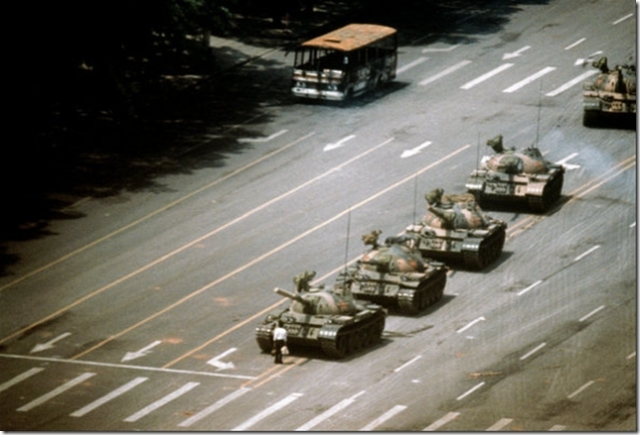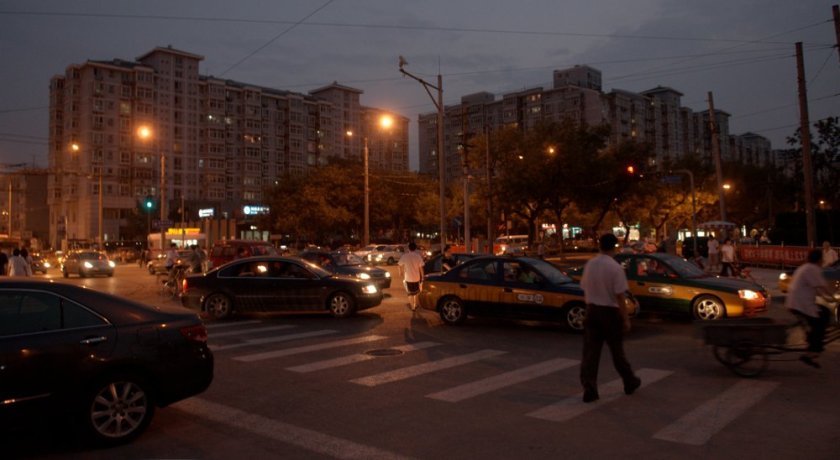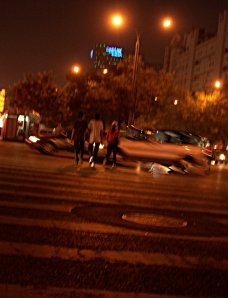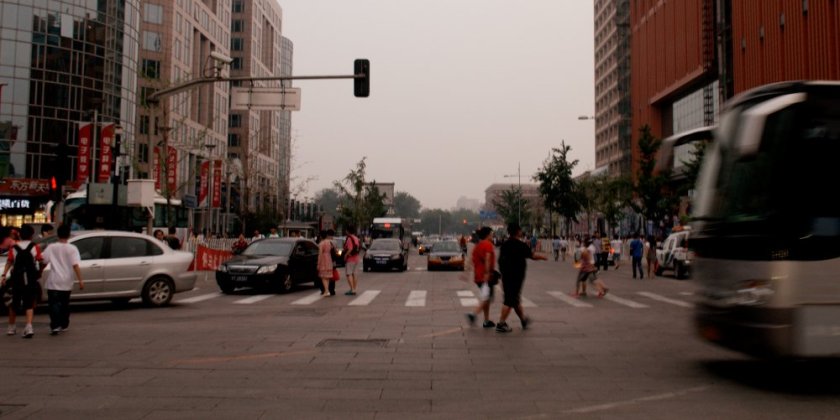 Beijing doesn’t exactly do shared space. Beijing is very much at the stage in its car dependency cycle where planners believe that new roads must be built, and that it’s possible to manage traffic. Perhaps the city authorities believe that traffic management can uniquely succeed in a dictatorship; perhaps they just haven’t noticed that it has failed in every other country.
Beijing doesn’t exactly do shared space. Beijing is very much at the stage in its car dependency cycle where planners believe that new roads must be built, and that it’s possible to manage traffic. Perhaps the city authorities believe that traffic management can uniquely succeed in a dictatorship; perhaps they just haven’t noticed that it has failed in every other country.
Beijing has traffic management features. The wide and regularly spaced boulevards that make up the old city’s grid are scattered with zebra crossings. Where two boulevards meet, their intersection is controlled with signals. And pedestrians walk on pavements, raised behind a curb — pavements that don’t even look noticeably foreign, like those North American ones do. On the famous Chang’an Avenue, between Tiananmen Square and the Forbidden City (pictured, above), the pavements and bicycle lanes are now even segregated from traffic by little metal barriers, and more railings and bollards are being installed every day.
 But Beijing traffic does look a lot like shared space, because all of the laws, signs, and hard engineering have zero effect on where, when, and how people actually drive. The residents of Beijing are actually not very good at being told what to do. Zebra crossings over the ten lane boulevards are meaningless; anybody hoping to cross the road must simply step out into it, with speeding cars seconds away, and hope for the best — or else give up their ambitions, and just get a car themselves. (Fortunately the Beijing police are cracking down on this reckless practice of jaywalking, with on the spot fines.) Though segregated dedicated bicycle lanes are the norm on these boulevards, they are wide enough for cars to drive down them — so cars do, just as they do on the pavement.
But Beijing traffic does look a lot like shared space, because all of the laws, signs, and hard engineering have zero effect on where, when, and how people actually drive. The residents of Beijing are actually not very good at being told what to do. Zebra crossings over the ten lane boulevards are meaningless; anybody hoping to cross the road must simply step out into it, with speeding cars seconds away, and hope for the best — or else give up their ambitions, and just get a car themselves. (Fortunately the Beijing police are cracking down on this reckless practice of jaywalking, with on the spot fines.) Though segregated dedicated bicycle lanes are the norm on these boulevards, they are wide enough for cars to drive down them — so cars do, just as they do on the pavement.
(On the motorway, signs on the overhead gantries reminded drivers that the hard shoulder — universally treated as the overtaking-on-the-inside lane — is not to be driven in; and underneath specified the hard shoulder’s width. As if to say, “NO! … Stop that! … Oh for christssake, at least don’t drive trucks in there, will you?”)
 This anarchy creates a situation that is very much like that proposed by shared space: there is little physical separation between transport modes — pedestrians are everywhere, bicycles are everywhere, and cars are everywhere; road, bike path, and pavement, and any and every combination. And everybody has to look out for each other: there is nobody and nothing in control to dictate who has right of way of any particular moment. The idea of shared space is that street users will find their environment unusual, complicated, and dangerous, and will compensate for the perceived heightened risks by slowing down and leaving more space. And within the lawless void of shared space, everybody will learn to wait their turn, and a de facto standard for who gives way in any situation will emerge.
This anarchy creates a situation that is very much like that proposed by shared space: there is little physical separation between transport modes — pedestrians are everywhere, bicycles are everywhere, and cars are everywhere; road, bike path, and pavement, and any and every combination. And everybody has to look out for each other: there is nobody and nothing in control to dictate who has right of way of any particular moment. The idea of shared space is that street users will find their environment unusual, complicated, and dangerous, and will compensate for the perceived heightened risks by slowing down and leaving more space. And within the lawless void of shared space, everybody will learn to wait their turn, and a de facto standard for who gives way in any situation will emerge.
In the anarchic situation in Beijing, drivers push and shove, dart into every little space that opens up, and lock themselves into tight knots at intersections. The moment the road ahead clears, they accelerate and brake to skilfully tailgate each other up to the next knot. They cut up cyclists when turning through their lane, and weave through lanes in front of scooters. They will ignore pedestrians trying to cross the road on the zebra crossing, and push past you at speed even if you’re already half way across. In Beijing, the only thing a car will give way to is a bus.
In Beijing, where the rules of the road are barely relevant, and where everybody drives, cycles and walks anywhere that it’s physically possible to do so, people don’t slow down, and they don’t drive carefully. There is no risk compensation because these conditions are the norm, and compensatory behaviour wears off when the risky situations become mundane and everyday. And so Beijing has absurdly high road death statistics (exactly how high will be explored later this week). But a de facto standard has emerged for who gives way: the biggest guy always owns the road, and it’s up to you to get out of his way before he reaches you. Might makes right of way.
And it’s not entirely clear why it would work any differently anywhere else.
















 From the World Health Organisation’s
From the World Health Organisation’s 

